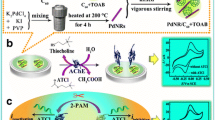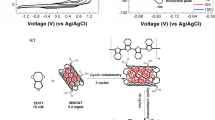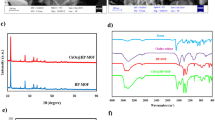Abstract
Enzyme-inorganic hybrid nanoflowers (HNFs) have shown excellent sensing capabilities due to their large specific surface area as well as the simplicity and mildness of the preparation process. However, coupling HNFs to electrodes to fabricate a uniform and controllable enzymatic electrochemical sensing interface remains a challenge. Here, we proposed an aptamer-induced in-situ fabrication strategy for preparing an HNF-based electrochemical sensor with ideal performance. Central to this strategy is the introduction of acetylcholinesterase (AChE)-specific binding aptamer (Apt), which induces the in-situ growth of AChE-copper phosphate (Cu3(PO4)2) HNFs on the surface of carbon paper (CP). In addition, a dense gold nanoparticle (AuNP) layer was electrodeposited on the CP for anchoring Apt and further extending the electroactive surface area. The prepared AChE-Cu3(PO4)2 HNF/Apt/AuNP/CP biosensor exhibited a wide detection range from 1 to 107 pM for the four organophosphorus inhibitors, including isocarbophos, dichlorvos, methamidophos, and parathion, with detection limits down to 0.016, 0.028, 0.071, and 0.113 pM, respectively. With the reactivation of pralidoxime chloride, the electrode can still recover 98.1% of the response after five times of repeated use. In real sample detection, the biosensor achieved high recoveries from 96.45% to 100.13%. The detection target may be extendable to other AChE inhibitors (e.g., drugs for Alzheimer’s disease). This study demonstrates for the first time the feasibility of using aptamers as an inducer to fabricate an electrochemical enzyme sensing interface in-situ. This strategy can be used to fabricate other enzyme-based biosensors and therefore has broader applications.

Similar content being viewed by others
References
Colović, M. B.; Krstić, D. Z.; Lazarević-Pašti, T. D.; Bondžić, A. M.; Vasić, V. M. Acetylcholinesterase inhibitors: Pharmacology and toxicology. Curr. Neuropharmacol. 2013, 11, 315–335.
Weng, R.; Lou, S. T.; Pang, X.; Song, Y.; Su, X.; **ao, Z. Y.; Qiu, J. Multi-residue analysis of 126 pesticides in chicken muscle by ultrahigh-performance liquid chromatography coupled to quadrupole time-of-flight mass spectrometry. Food Chem. 2020, 309, 125503.
Moinfar, S.; Khodayari, A.; Abdulrahman, S. S.; Aghaei, A.; Sohrabnezhad, S.; Jamil, L. A. Development of a SPE/GC-MS method for the determination of organophosphorus pesticides in food samples using syringe filters packed by GNP/MIL-101(Cr) nanocomposite. Food Chem. 2022, 371, 130997.
Jain, U.; Saxena, K.; Hooda, V.; Balayan, S.; Singh, A. P.; Tikadar, M.; Chauhan, N. Emerging vistas on pesticides detection based on electrochemical biosensors—An update. Food Chem. 2022, 371, 131126.
Alex, A. V.; Mukherjee, A. Review of recent developments (2018–2020) on acetylcholinesterase inhibition based biosensors for organophosphorus pesticides detection. Microchem. J. 2021, 161, 105779.
Cao, J.; Wang, M.; Yu, H.; She, Y. X.; Cao, Z.; Ye, J. M.; Abd El-Aty, A. M.; Hacımüftüoğlu, A.; Wang, J.; Lao, S. B. An overview on the mechanisms and applications of enzyme inhibition-based methods for determination of organophosphate and carbamate pesticides. J. Agric. Food Chem. 2020, 68, 7298–7315.
Zhong, H. T.; Xue, Y. T.; Zhang, P. Y.; Liu, B.; Zhang, X.; Chen, Z. B.; Li, K.; Zheng, L. R.; Zuo, X. Cascade reaction system integrating nanozymes for colorimetric discrimination of organophosphorus pesticides. Sens. Actuators B: Chem. 2022, 350, 130810.
Zhang, W. H.; Yin, M. J.; Zhao, Q.; **, C. G.; Wang, N. X.; Ji, S. L.; Ritt, C. L.; Elimelech, M.; An, Q. F. Graphene oxide membranes with stable porous structure for ultrafast water transport. Nat. Nanotechnol. 2021, 16, 337–343.
Zhou, X. Y.; Wang, C. C.; Wu, L. N.; Wei, W.; Liu, S. Q. An OliGreen-responsive fluorescence sensor for sensitive detection of organophosphorus pesticide based on its specific selectivity towards T-Hg2+-T DNA structure. Spectrochim. Acta Part A Mol Biomol. Spectrosc. 2021, 247, 119155.
Yao, T. T.; Liu, A. R.; Liu, Y.; Wei, M.; Wei, W.; Liu, S. Q. Ratiometric fluorescence sensor for organophosphorus pesticide detection based on opposite responses of two fluorescence reagents to MnO2 nanosheets. Biosens. Bioelectron. 2019, 145, 111705.
Wu, J. H.; Yang, Q. T.; Li, Q.; Li, H. Y.; Li, F. Two-dimensional MnO2 nanozyme-mediated homogeneous electrochemical detection of organophosphate pesticides without the interference of H2O2 and color. Anal. Chem. 2021, 93, 4084–4091.
Cui, H. F.; Zhang, T. T.; Lv, Q. Y.; Song, X. J.; Zhai, X. J.; Wang, G. G. An acetylcholinesterase biosensor based on do** Au nanorod@SiO2 nanoparticles into TiO2-chitosan hydrogel for detection of organophosphate pesticides. Biosens. Bioelectron. 2019, 141, 111452.
Cui, H. F.; Wu, W. W.; Li, M. M.; Song, X. J.; Lv, Y. X.; Zhang, T. T. A highly stable acetylcholinesterase biosensor based on chitosan-TiO2-graphene nanocomposites for detection of organophosphate pesticides. Biosens. Bioelectron. 2018, 99, 223–229.
Kurbanoglu, S.; Ozkan, S. A.; Merkoçi, A. Nanomaterials-based enzyme electrochemical biosensors operating through inhibition for biosensing applications. Biosens. Bioelectron. 2017, 89, 886–898.
Arduini, F.; Cinti, S.; Scognamiglio, V.; Moscone, D. Nanomaterials in electrochemical biosensors for pesticide detection: Advances and challenges in food analysis. Microchim. Acta 2016, 183, 2063–2083.
Yan, X. N.; Deng, J.; Xu, J. S.; Li, H.; Wang, L. L.; Chen, D.; **e, J. A novel electrochemical sensor for isocarbophos based on a glassy carbon electrode modified with electropolymerized molecularly imprinted terpolymer. Sens. Actuators B: Chem. 2012, 171–172, 1087–1094.
Bilal, S.; Sami, A. J.; Hayat, A.; Rehman, M. F. U. Assessment of pesticide induced inhibition of Apis mellifera (honeybee) acetylcholinesterase by means of N-doped carbon dots/BSA nanocomposite modified electrochemical biosensor. Bioelectrochemistry 2022, 144, 107999.
Niu, K.; Gao, J.; Wu, L. X.; Lu, X. B.; Chen, J. P. Nitrogen-doped graphdiyne as a robust electrochemical biosensing platform for ultrasensitive detection of environmental pollutants. Anal. Chem. 2021, 93, 8656–8662.
Zhang, J. H.; Hu, H. Y.; Yang, L. Q. Ultra-highly sensitive and stable acetylcholinesterase biosensor based on TiO2-NRs and rGO. Microchem. J. 2021, 168, 106435.
An, Y. Q.; Dong, S. Y.; He, Z. X.; **e, Q.; Huang, T. L. Heteroatom-doped Co-MOF derivative enhancing immobilization and activity of two enzymes for small-molecules electrochemical determination. Microchem. J. 2022, 172, 106942.
Eş, I.; Vieira, J. D. G.; Amaral, A. C. Principles, techniques, and applications of biocatalyst immobilization for industrial application. Appl. Microbiol. Biotechnol. 2015, 99, 2065–2082.
Ge, J.; Lei, J. D.; Zare, R. N. Protein-inorganic hybrid nanoflowers. Nat. Nanotechnol. 2012, 7, 428–432.
Parkash, A. Metal-organic framework derived ultralow-loading platinum-copper catalyst: A highly active and durable bifunctional electrocatalyst for oxygen-reduction and evolution reactions. Nanotechnology 2021, 32, 325703.
Gao, J. J.; Liu, H.; Tong, C.; Pang, L. Y.; Feng, Y. Q.; Zuo, M. G.; Wei, Z. Q.; Li, J. Q. Hemoglobin-Mn3(PO4)2 hybrid nanoflower with opulent electroactive centers for high-performance hydrogen peroxide electrochemical biosensor. Sens. Actuators B: Chem. 2020, 307, 127628.
**, R.; Kong, D. S.; Zhao, X.; Li, H. X.; Yan, X.; Liu, F. M.; Sun, P.; Du, D.; Lin, Y. H.; Lu, G. Y. Tandem catalysis driven by enzymes directed hybrid nanoflowers for on-site ultrasensitive detection of organophosphorus pesticide. Biosens. Bioelectron. 2019, 141, 111473.
Yin, Y. Q.; **ao, Y.; Lin, G.; **ao, Q.; Lin, Z. A.; Cai, Z. W. An enzyme-inorganic hybrid nanoflower based immobilized enzyme reactor with enhanced enzymatic activity. J. Mater. Chem. B 2015, 3, 2295–2300.
Kostadinova, O.; Kochnitcharova, D.; Lefterova, E.; Shipochka, M.; Angelov, P.; Petkova, T. Network modification of phosphate materials by transition metals do**. Bulg. Chem. Commun. 2018, 50, 50–54.
Liang, X.; Liu, Y.; Wen, K.; Jiang, W.; Li, Q. S. Immobilized enzymes in inorganic hybrid nanoflowers for biocatalytic and biosensing applications. J. Mater. Chem. B 2021, 9, 7597–7607.
Wang, S.; Huo, R. F.; Zhang, R.; Zheng, Y. C.; Li, C. J.; Pan, L. Synthesis of core-shell N−TiO2@CuOx with enhanced visible light photocatalytic performance. RSC Adv. 2018, 8, 24866–24872.
Kim, K. H.; Jeong, J. M.; Lee, S. J.; Choi, B. G.; Lee, K. G. Protein-directed assembly of cobalt phosphate hybrid nanoflowers. J. Colloid Interface Sci. 2016, 484, 44–50.
Engelen, W.; Janssen, B. M. G.; Merkx, M. DNA-based control of protein activity. Chem. Commun. 2016, 52, 3598–3610.
Liu, Y.; Lin, C. X.; Li, H. Y.; Yan, H. Aptamer-directed self-assembly of protein arrays on a DNA nanostructure. Angew. Chem., Int. Ed. 2005, 44, 4333–4338.
Lu, Q. Y.; Hu, Y. X.; Li, C. Y.; Kuang, Y. Aptamer-array-guided protein assembly enhances synthetic mRNA switch performance. Angew. Chem., Int. Ed. 2022, 61, e202207319.
Le, T. T.; Chumphukam, O.; Cass, A. E. G. Determination of minimal sequence for binding of an aptamer. A comparison of truncation and hybridization inhibition methods. RSC Adv. 2014, 4, 47227–47233.
Yang, L. M.; Zhang, X. L.; Li, M. M.; Qu, L. J.; Liu, Z. Acetylcholinesterase-Cu3(PO4)2 hybrid nanoflowers for electrochemical detection of dichlorvos using square-wave voltammetry. Anal. Methods 2022, 14, 3911–3920.
Gao, J. J.; Liu, H.; Pang, L. Y.; Guo, K.; Li, J. Q. Biocatalyst and colorimetric/fluorescent dual biosensors of H2O2 constructed via hemoglobin-Cu3(PO4)2 organic/inorganic hybrid nanoflowers. ACS Appl. Mater. Interfaces 2018, 10, 30441–30450.
Wahab, A. K.; Bashir, S.; Al-Salik, Y.; Idriss, H. Ethanol photoreactions over Au-Pd/TiO2. Appl. Petrochem. Res. 2014, 4, 55–62.
Wei, S. T.; Qi, K.; **, Z.; Cao, J. S.; Zheng, W. T.; Chen, H.; Cui, X. Q. One-step synthesis of a self-supported copper phosphide nanobush for overall water splitting. ACS Omega 2016, 1, 1367–1373.
Ioakeimidis, A.; Papadas, I. T.; Koutsouroubi, E. D.; Armatas, G. S.; Choulis, S. A. Thermal analysis of metal-organic precursors for functional Cu:NiOx hole transporting layer in inverted perovskite solar cells: Role of solution combustion chemistry in Cu:NiOx thin films processing. Nanomaterials 2021, 11, 3074.
Li, Z. Z.; **n, Y. M.; Zhang, Z. H.; Wu, H. J.; Wang, P. Rational design of binder-free noble metal/metal oxide arrays with nanocauliflower structure for wide linear range nonenzymatic glucose detection. Sci. Rep. 2015, 5, 10617.
Zeng, J.; **a, Y. N. Not just a pretty flower. Nat. Nanotechnol. 2012, 7, 415–416.
Itsoponpan, T.; Thanachayanont, C.; Hasin, P. Sponge-like CuInS2 microspheres on reduced graphene oxide as an electrocatalyst to construct an immobilized acetylcholinesterase electrochemical biosensor for chlorpyrifos detection in vegetables. Sens. Actuators B: Chem. 2021, 337, 129775.
Song, D. D.; Jiang, X. Y.; Li, Y. S.; Lu, X.; Luan, S. R.; Wang, Y. Z.; Li, Y.; Gao, F. M. Metal-organic frameworks-derived MnO2/Mn3O4 microcuboids with hierarchically ordered nanosheets and TI3C2 MXene/Au NPs composites for electrochemical pesticide detection. J. Hazard. Mater. 2019, 373, 367–376.
Zhao, Y. S.; Li, X. L.; Chen, J. M.; Lu, X.; Yang, Y. X.; Song, D. D.; Gao, F. M. Porous hierarchical peony-like cobalt-based bimetallic oxides structured by ultrathin nanosheets for highly sensitive electrochemical pesticides detection. Sens. Actuators B: Chem. 2022, 352, 131072.
Tutunaru, O.; Mihailescu, C. M.; Savin, M.; Tincu, B. C.; Stoian, M. C.; Muscalu, G. S.; Firtat, B.; Dinulescu, S.; Craciun, G.; Moldovan, C. A. et al. Acetylcholinesterase entrapment onto carboxyl-modified single-walled carbon nanotubes and poly(3,4-ethylenedioxythiophene) nanocomposite, film electrosynthesis characterization, and sensor application for dichlorvos detection in apple juice. Microchem. J. 2021, 169, 106573.
Bilal, S.; Mudassir Hassan, M.; Fayyaz ur Rehman, M.; Nasir, M.; Jamil Sami, A.; Hayat, A. An insect acetylcholinesterase biosensor utilizing WO3/g-C3N4 nanocomposite modified pencil graphite electrode for phosmet detection in stored grains. Food Chem. 2021, 346, 128894.
Acknowledgements
We acknowledge funding from the National Natural Science Foundation of China (No. 31871878).
Author information
Authors and Affiliations
Corresponding authors
Electronic Supplementary Material
12274_2023_5528_MOESM1_ESM.pdf
Aptamer-induced in-situ growth of acetylcholinesterase-Cu3(PO4)2 hybrid nanoflowers for electrochemical detection of organophosphorus inhibitors
Rights and permissions
About this article
Cite this article
Yang, L., Qu, L., Zhang, X. et al. Aptamer-induced in-situ growth of acetylcholinesterase-Cu3(PO4)2 hybrid nanoflowers for electrochemical detection of organophosphorus inhibitors. Nano Res. 16, 12134–12143 (2023). https://doi.org/10.1007/s12274-023-5528-y
Received:
Revised:
Accepted:
Published:
Issue Date:
DOI: https://doi.org/10.1007/s12274-023-5528-y




